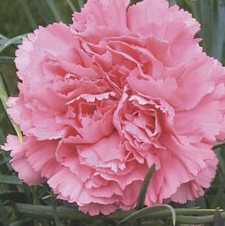 Carnations are short-lived herbaceous perennials native to the Mediterranean where they grow in pockets of soil in limestone formations. They have been cultivated for over 2000 years and have been selected so that most of the familiar ones are best grown in greenhouses for the florist trade. The grey-green foliage is linear and evergreen . The flowers are produced singly or in clusters of five in summer and usually have a strong sweet clove fragrance. The species was originally bright pinkish purple but white, yellow, red, purple, and green cultivars have been developed. Plants are short lived and must be divided every other year to maintain vigor. The flowers have a vase life of one to two weeks and are excellent for corsages. The generic name, Dianthus, comes from the Greek words dios, meaning divine, and anthos meaning flower. The specific epithet, caryophyllus, comes from the Greek words karya meaning walnut and phyllon meaning leaf, referring to the smell of walnuts which led to the used of the name for clove and then to carnations. The common name, carnation, is also used for other plants, and may be dervived from the Greek word corone meaning flower garland, in reference to the fact that carnations were used for ceremonial crowns in ancient times.
Carnations are short-lived herbaceous perennials native to the Mediterranean where they grow in pockets of soil in limestone formations. They have been cultivated for over 2000 years and have been selected so that most of the familiar ones are best grown in greenhouses for the florist trade. The grey-green foliage is linear and evergreen . The flowers are produced singly or in clusters of five in summer and usually have a strong sweet clove fragrance. The species was originally bright pinkish purple but white, yellow, red, purple, and green cultivars have been developed. Plants are short lived and must be divided every other year to maintain vigor. The flowers have a vase life of one to two weeks and are excellent for corsages. The generic name, Dianthus, comes from the Greek words dios, meaning divine, and anthos meaning flower. The specific epithet, caryophyllus, comes from the Greek words karya meaning walnut and phyllon meaning leaf, referring to the smell of walnuts which led to the used of the name for clove and then to carnations. The common name, carnation, is also used for other plants, and may be dervived from the Greek word corone meaning flower garland, in reference to the fact that carnations were used for ceremonial crowns in ancient times.
Type: herbaceous perennial
Bloom: Pink, red, white, yellow, purple, green flowers usually with strong sweet clove fragrance in summer
Size: 2’ H x 4’ W (if not tied up)
Light: Full sun
Soil: Fertile, moist, well-drained, limy (drainage is critical).
Hardiness: Zones 6-8
Care: High maintenance; grow in greenhouse; steak plants, divide every other year.
Pests and Diseases: Many viral, bacterial, fungal diseases and insect pests.
Propagation: Slip cuttings in spring and summer